Background:
In the experiment we will be applying the gas laws to the function of the respirometer to observe cellular respiration of germinating and non-germinating cells. The decrease in volume will correlate with the number of oxygen molecules taken in during respiration by the pea seeds. Beads in a glass vial will act as the control; all data will be fixed based off the external influences on the respirometer.
In the experiment we will be applying the gas laws to the function of the respirometer to observe cellular respiration of germinating and non-germinating cells. The decrease in volume will correlate with the number of oxygen molecules taken in during respiration by the pea seeds. Beads in a glass vial will act as the control; all data will be fixed based off the external influences on the respirometer.
| Steps:
|
Hypothesis:
If the water is warmer then the germinated peas will be able to perform cellular respiration faster.
Data:
*Since my group's experiment was inconclusive all of the following data is provided by Mrs. Blake*
Reading at 24 C (room temperature)
Glass Beads only |
||
Minutes |
Reading at the time X |
Difference |
0.63 |
x |
|
5 |
0.62 |
0.01 |
10 |
0.61 |
0.02 |
15 |
0.61 |
0.02 |
20 |
0.61 |
0.02 |
Germinating Peas |
||
Reading at time X |
Difference |
corrected differnce |
0.64 |
x |
x |
0.55 |
0.09 |
0.08 |
0.44 |
0.20 |
0.18 |
0.33 |
0.31 |
0.29 |
0.22 |
0.42 |
0.40 |
Dry peas with glass beads |
||
Reading time at x |
difference |
corrected difference |
0.65 |
x |
x |
064 |
0.01 |
0.00 |
0.62 |
0.03 |
0.01 |
0.61 |
0.04 |
0.02 |
0.61 |
0.04 |
0.02 |
reading at 10 C
Glass beads only |
||
minutes |
Reading as time x |
difference |
Value |
0.65 |
x |
5 |
0.64 |
0.01 |
10 |
0.63 |
0.02 |
15 |
0.62 |
0.03 |
20 |
0.62 |
0.03 |
Germinating Peas |
Value |
|
Reading time at x |
difference |
corrected difference |
0.66 |
x |
x |
0.61 |
0.05 |
0.04 |
0.58 |
0.08 |
0.06 |
0.56 |
0.10 |
0.09 |
0.53 |
0.13 |
0.10 |
Dry peas with glass beads |
||
Reading at time x |
difference |
corrected difference |
0.64 |
x |
x |
0.63 |
0.01 |
0.00 |
0.62 |
0.02 |
0.00 |
0.61 |
0.03 |
0.00 |
0.60 |
0.04 |
0.01 |
Study Questions:
1. Graph your corrected data (difference) for vials A, B, C, D, E, and F. Place time (in minutes) on the x-axis and volume (ml O2 consumed) on the y-axis. Data from both temperatures should be plotted on the same graph. Draw the best straight line through the data points.
Every vial would have to start at the point of 0 for sure. Vial D and Vial A produced the most oxygen because they contained the germinated seeds. Every other vial didn't produce more because they were the controls. The graph depicts how much oxygen is produced over a 20 minute time period.
1. Graph your corrected data (difference) for vials A, B, C, D, E, and F. Place time (in minutes) on the x-axis and volume (ml O2 consumed) on the y-axis. Data from both temperatures should be plotted on the same graph. Draw the best straight line through the data points.
Every vial would have to start at the point of 0 for sure. Vial D and Vial A produced the most oxygen because they contained the germinated seeds. Every other vial didn't produce more because they were the controls. The graph depicts how much oxygen is produced over a 20 minute time period.
2. What accounts for the difference in oxygen consumption seen between the germinating and non-germinating seeds?
Germinating seeds have already come out of dormancy and are ready to produce energy so they can grow whereas non-germinating want aren't in the position to start growing and produce max energy.
3. List some of the constant controls in this experiment.
The controls are the glass beads and the non-germinated peas + glass beads because neither perform cellular respiration.
4. Why do the glass beads seem to be using oxygen?
An air bubble is formed that had already been in the tube and then the water created pressure that made an air bubble form in the respirometer.
5. Why are the readings corrected using the glass bead values?
They are corrected because they have to be zeroed out. Like I said before, glass beads can not use the process of cellular respiration due the fact that they aren't living. So whatever oxygen was formed didn't count.
6. What is the function of KOH in this experiment?
The KOH is there to make sure that the carbon dioxide levels go down to not affect the gas volume.
7. From the slope of the lines, determine the rate of oxygen consumption at 10°C room temperature for the germinating and non-germinating pea seeds. Determine the slope of the lines over a middle section of each line by dividing the difference in volume reading by the difference in time. Volume (ml O2 consumed) values are determined from the line.
Germinating seeds have already come out of dormancy and are ready to produce energy so they can grow whereas non-germinating want aren't in the position to start growing and produce max energy.
3. List some of the constant controls in this experiment.
The controls are the glass beads and the non-germinated peas + glass beads because neither perform cellular respiration.
4. Why do the glass beads seem to be using oxygen?
An air bubble is formed that had already been in the tube and then the water created pressure that made an air bubble form in the respirometer.
5. Why are the readings corrected using the glass bead values?
They are corrected because they have to be zeroed out. Like I said before, glass beads can not use the process of cellular respiration due the fact that they aren't living. So whatever oxygen was formed didn't count.
6. What is the function of KOH in this experiment?
The KOH is there to make sure that the carbon dioxide levels go down to not affect the gas volume.
7. From the slope of the lines, determine the rate of oxygen consumption at 10°C room temperature for the germinating and non-germinating pea seeds. Determine the slope of the lines over a middle section of each line by dividing the difference in volume reading by the difference in time. Volume (ml O2 consumed) values are determined from the line.
Experimental Conditions |
Calculations |
Rate in ml O2/ minutes (slope) |
Germinated @ 10° C |
0.05ml/5 minutes |
.002 O2/minute |
Germinated @ 24° C |
.10ml/5 minutes |
.002 O2/minute |
Dry peas @ 10° C |
0.01ml/5 minutes |
.01 O2/minute |
Dry peas @ 24° C |
0.01ml/5 minutes |
.02 O2/minute |
8. Compare the rate of oxygen consumption at 10°C and room temperature. How are they different?
The peas produced more oxygen when they were submerged in room temperature water because this gives the peas optimal temperature to perform cellular respiration. The colder temperature makes the process slower. It makes the oxygen consumption different for each since they function differently.
9. How do you think the rates of respiration would change in peas that have been germinating for 0, 24, 48, 72, and 96 hours. Why?
I think the longer the time period the more cellular respiration will occur. Since we only had a short time period only small oxygen bubble were formed. From the time period of 0 to 96 hours the rate of cellular respiration would increase. We can compare it to a stove, when it first starts heating up it isn't automatically all the way up. It takes time to accelerate to produce maximum heat.
10. Write a hypothesis using the same experimental design to compare the rates of respiration in a mouse at both room temperature 24° C and at 10° C.
If the was exposed to room temperature room compared to a 10° C degree it would perform cellular respiration faster.
11. Using the same experimental design, write a hypothesis to test the respiration rate of a 15 g reptile and a 15 g mammal at 10° C.
If a 15 g reptile and a 15 g mammal were placed into a 10 ° C room then the mammal would reach its peak for cellular respiration first before the reptile because reptiles need heat to function correctly since they are cold blooded.
12. What basic cellular process is responsible for the oxygen consumption?
Cellular respiration is responsible for the oxygen consumption.
Conclusion:
To finish this lab report, my hypothesis was proven to be correct. In warmer temperatures, more oxygen is consumed because the seedlings are more likely to use the process of photosynthesis. This process releases oxygen which they released and we were able to read in our experiment. This data also shows that the germinated peas performed better compared to the dry peas.
In our original experiment the reason we might've gotten inconclusive data could've been simple errors that we didn't catch. Who knows, we might not have put the cork back on tightly enough or maybe too much KOH solution was added and it would have touched our seedlings. Whatever the case we have no cellular respiration happen to any of our vials.
The peas produced more oxygen when they were submerged in room temperature water because this gives the peas optimal temperature to perform cellular respiration. The colder temperature makes the process slower. It makes the oxygen consumption different for each since they function differently.
9. How do you think the rates of respiration would change in peas that have been germinating for 0, 24, 48, 72, and 96 hours. Why?
I think the longer the time period the more cellular respiration will occur. Since we only had a short time period only small oxygen bubble were formed. From the time period of 0 to 96 hours the rate of cellular respiration would increase. We can compare it to a stove, when it first starts heating up it isn't automatically all the way up. It takes time to accelerate to produce maximum heat.
10. Write a hypothesis using the same experimental design to compare the rates of respiration in a mouse at both room temperature 24° C and at 10° C.
If the was exposed to room temperature room compared to a 10° C degree it would perform cellular respiration faster.
11. Using the same experimental design, write a hypothesis to test the respiration rate of a 15 g reptile and a 15 g mammal at 10° C.
If a 15 g reptile and a 15 g mammal were placed into a 10 ° C room then the mammal would reach its peak for cellular respiration first before the reptile because reptiles need heat to function correctly since they are cold blooded.
12. What basic cellular process is responsible for the oxygen consumption?
Cellular respiration is responsible for the oxygen consumption.
Conclusion:
To finish this lab report, my hypothesis was proven to be correct. In warmer temperatures, more oxygen is consumed because the seedlings are more likely to use the process of photosynthesis. This process releases oxygen which they released and we were able to read in our experiment. This data also shows that the germinated peas performed better compared to the dry peas.
In our original experiment the reason we might've gotten inconclusive data could've been simple errors that we didn't catch. Who knows, we might not have put the cork back on tightly enough or maybe too much KOH solution was added and it would have touched our seedlings. Whatever the case we have no cellular respiration happen to any of our vials.
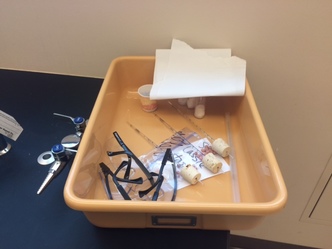
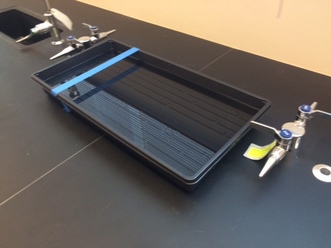
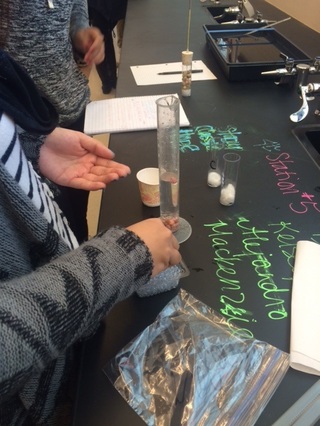
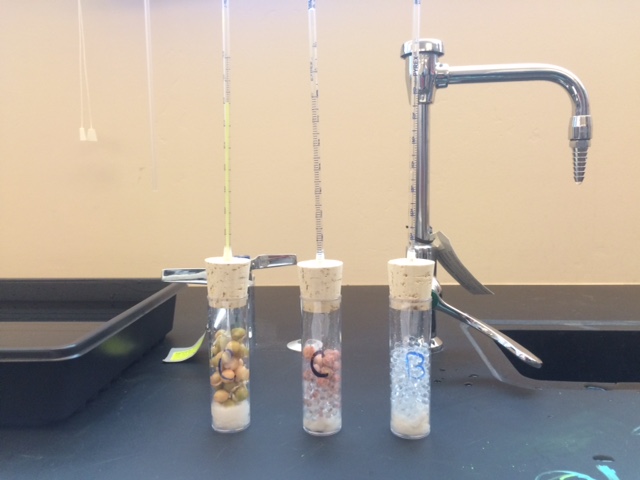
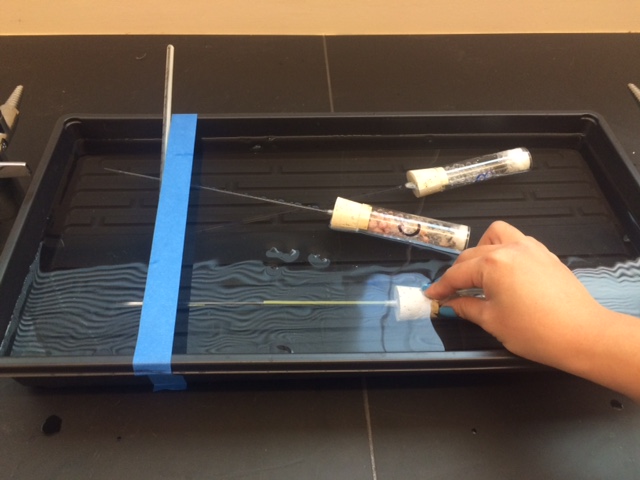
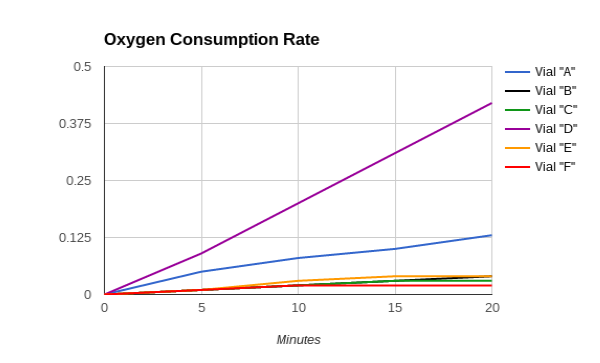
 RSS Feed
RSS Feed
